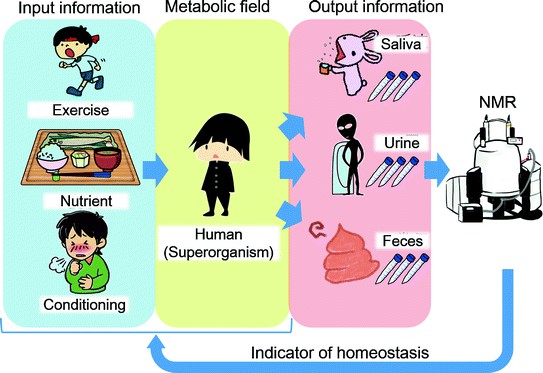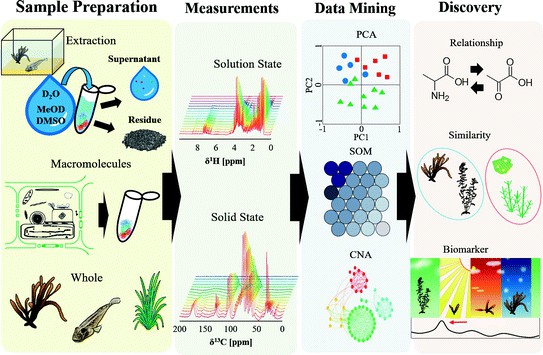Metabolic Profiling for Molecular Complexity
Metabolites are the final products of biological processes. Metabolism spectrum or metabolomics is the study of organic metabolites in cells, tissues, and biological fluids. The metabolomics study provides a comprehensive data set from the target sample. NMR has great advantages in analyzing the molecular complexity of natural mixtures.
As an expert in the field of nuclear magnetic resonance, Creative Biostructure, relying on solid and liquid NMR technology, provides customers with metabolomics and metabolic spectrum analysis services of small molecular complexity, as well as biomass analysis services of large molecular complexity.
Why Use NMR for Metabolic Profiling
- NMR is suitable for a variety of sample systems, from crude extracts to complete biological tissues, from small molecules to macromolecular complexes, and interaction studies.
- With the assistance of stable isotope tracer experiments, NMR can provide site-specific and atomic-specific information.
- Homogeneous and stable isotope labeling in biological samples enables NMR to be used in two-dimensional and three-dimensional experiments.
- Interchangeability of NMR spectral data between laboratories around the world.
- The reproducibility and quantification ability of NMR are also the main advantages.
Metabolomics and Metabolic Profiling for Molecular Complexity
Internal balance is to maintain the internal physiological environment within a certain range to resist the changes in the external environment. The pathological state destroys homeostasis and changes the composition and/or profile of metabolites. Metabolomics has great potential in diagnosing and monitoring diseases using blood, saliva, urine, and stool samples. NMR is usually used for further multivariate analysis of the NMR spectra of small biomolecular mixtures to determine metabolites biomarkers and evaluate the nutritional components in foods.
Our Solutions
Molecular complexity analysis method scheme based on nuclear magnetic resonance. Small (or large) molecular mixtures are directly subjected to multiple NMR experiments without any chromatographic separation. Digitize (sometimes merge) the obtained congestion signals into the numerical list, and then apply various data science methods, including principal component analysis (PCA), self-organization mapping (SOM), and correlation network analysis (CAN).
 Figure 1. Conceptual figure to elucidate metabonomics as an indicator of homeostatic response in the human superorganism from input to output information analyzed by NMR (Kikuchi, 2017)
Figure 1. Conceptual figure to elucidate metabonomics as an indicator of homeostatic response in the human superorganism from input to output information analyzed by NMR (Kikuchi, 2017)
NMR Measurements and Data Processing
| NMR Measurements | Description |
|---|---|
| 2D J-resolved spectroscopy | It is used to determine spin-spin coupling constants that can then be used for structural analysis. |
| Multidimensional NMR | It is used to analyze correlation signals between homo- and heteronuclear experiments to identify metabolites. |
| HSQC | In heteronuclear single quantum coherence (HSQC), metabolites can be identified by comparison with a chemical shift database and measured HSQC spectra. |
| To increase identification accuracy | Correlation spectroscopy (COSY), totally correlated spectroscopy (TOCSY), and single quantum–double quantum correlation spectroscopy (SQ-DQ) is used to confirm correlation signals with adjacent atoms. Using HSQC-TOCSY and 3D HCCH-COSY together, adjacent correlation signals of annotated metabolites on HSQC spectra are easily confirmed |
Databases and Tools for NMR Analysis
Chemical shift databases for metabolomics
- Human Metabolome Database (HMDB)
- Biological Magnetic Resonance Bank (BMRB)
- Madison Metabolomics Consortium Database (MMCD)
Metabolic Profiling of Plant, Animal, and Microbial Systems
 Figure 2. Scheme of NMR-based profiling approach for molecular complexity. (Kikuchi, 2017)
Figure 2. Scheme of NMR-based profiling approach for molecular complexity. (Kikuchi, 2017)
Application to Plant Systems
Our services include
- Metabolic analysis using 1H NMR simultaneously tracks changes in metabolites in plants and algae.
- Multivariate analysis (such as PCA) was used to characterize differences based on geographical sources and plant varieties.
- Detect the content and difference of low molecular weight molecules (such as amino acids, organic acids and sugars).
- Use DMSO as a solvent to evaluate low molecular weight molecules and polymers.
Application to Animal Systems
We use the NMR-based metabolomics method to help customers study the metabolic characteristics of animals and their intestinal symbiosis systems.
The method of combining 13C labeling with multi-dimensional NMR analysis was used to separate the crowded signal from the metabolite mixture. We can conduct quantitative and multivariate analysis of the time series in the acquired data at the atomic level.
Application to Microbial Systems
Through NMR technology based on the 13C labeling method, we complete the characterization of compounds in complex components, determination of compound structure and trace of microbial metabolic pathway for customers.
Creative Biostructure is committed to providing high-quality NMR analysis services to advance the life sciences fields. If you have any questions or needs, please contact us and our customer service staff will help you the first time.
Ordering Process
Reference
- Kikuchi J. NMR analysis of molecular complexity. Experimental Approaches of NMR Spectroscopy: Methodology and Application to Life Science and Materials Science. 2018: 461-489.
